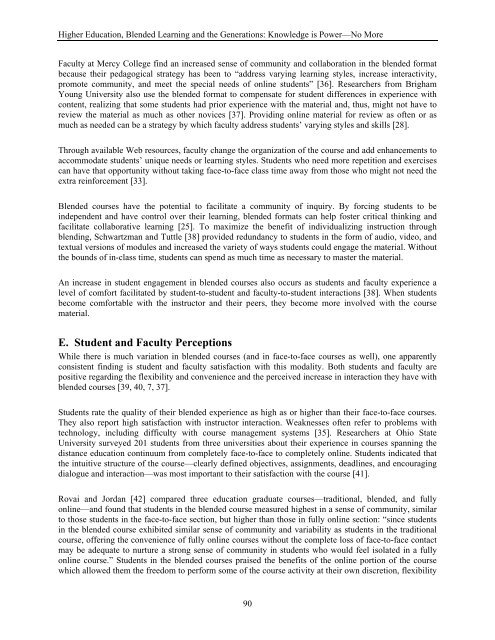Elements of Quality Online Education cation
Elements of Quality Online Education cation
Elements of Quality Online Education cation
You also want an ePaper? Increase the reach of your titles
YUMPU automatically turns print PDFs into web optimized ePapers that Google loves.
Higher <strong>Edu<strong>cation</strong></strong>, Blended Learning and the Generations: Knowledge is Power—No MoreFaculty at Mercy College find an increased sense <strong>of</strong> community and collaboration in the blended formatbecause their pedagogical strategy has been to “address varying learning styles, increase interactivity,promote community, and meet the special needs <strong>of</strong> online students” [36]. Researchers from BrighamYoung University also use the blended format to compensate for student differences in experience withcontent, realizing that some students had prior experience with the material and, thus, might not have toreview the material as much as other novices [37]. Providing online material for review as <strong>of</strong>ten or asmuch as needed can be a strategy by which faculty address students’ varying styles and skills [28].Through available Web resources, faculty change the organization <strong>of</strong> the course and add enhancements toaccommodate students’ unique needs or learning styles. Students who need more repetition and exercisescan have that opportunity without taking face-to-face class time away from those who might not need theextra reinforcement [33].Blended courses have the potential to facilitate a community <strong>of</strong> inquiry. By forcing students to beindependent and have control over their learning, blended formats can help foster critical thinking andfacilitate collaborative learning [25]. To maximize the benefit <strong>of</strong> individualizing instruction throughblending, Schwartzman and Tuttle [38] provided redundancy to students in the form <strong>of</strong> audio, video, andtextual versions <strong>of</strong> modules and increased the variety <strong>of</strong> ways students could engage the material. Withoutthe bounds <strong>of</strong> in-class time, students can spend as much time as necessary to master the material.An increase in student engagement in blended courses also occurs as students and faculty experience alevel <strong>of</strong> comfort facilitated by student-to-student and faculty-to-student interactions [38]. When studentsbecome comfortable with the instructor and their peers, they become more involved with the coursematerial.E. Student and Faculty PerceptionsWhile there is much variation in blended courses (and in face-to-face courses as well), one apparentlyconsistent finding is student and faculty satisfaction with this modality. Both students and faculty arepositive regarding the flexibility and convenience and the perceived increase in interaction they have withblended courses [39, 40, 7, 37].Students rate the quality <strong>of</strong> their blended experience as high as or higher than their face-to-face courses.They also report high satisfaction with instructor interaction. Weaknesses <strong>of</strong>ten refer to problems withtechnology, including difficulty with course management systems [35]. Researchers at Ohio StateUniversity surveyed 201 students from three universities about their experience in courses spanning thedistance edu<strong>cation</strong> continuum from completely face-to-face to completely online. Students indicated thatthe intuitive structure <strong>of</strong> the course—clearly defined objectives, assignments, deadlines, and encouragingdialogue and interaction—was most important to their satisfaction with the course [41].Rovai and Jordan [42] compared three edu<strong>cation</strong> graduate courses—traditional, blended, and fullyonline—and found that students in the blended course measured highest in a sense <strong>of</strong> community, similarto those students in the face-to-face section, but higher than those in fully online section: “since studentsin the blended course exhibited similar sense <strong>of</strong> community and variability as students in the traditionalcourse, <strong>of</strong>fering the convenience <strong>of</strong> fully online courses without the complete loss <strong>of</strong> face-to-face contactmay be adequate to nurture a strong sense <strong>of</strong> community in students who would feel isolated in a fullyonline course.” Students in the blended courses praised the benefits <strong>of</strong> the online portion <strong>of</strong> the coursewhich allowed them the freedom to perform some <strong>of</strong> the course activity at their own discretion, flexibility90
















